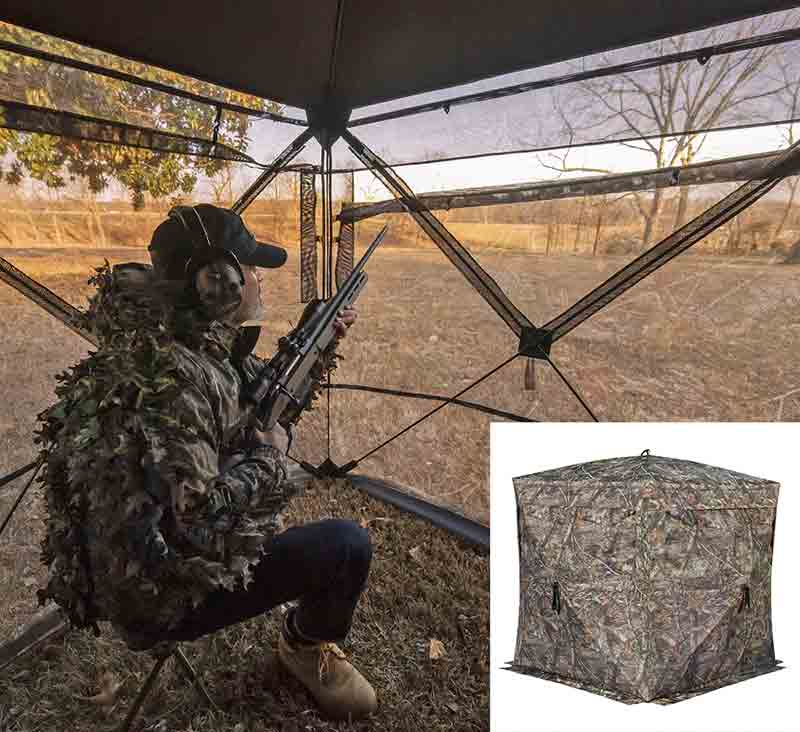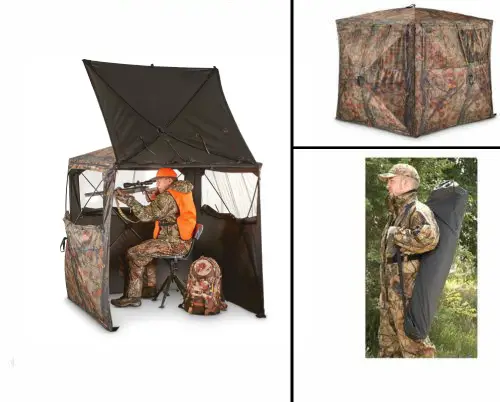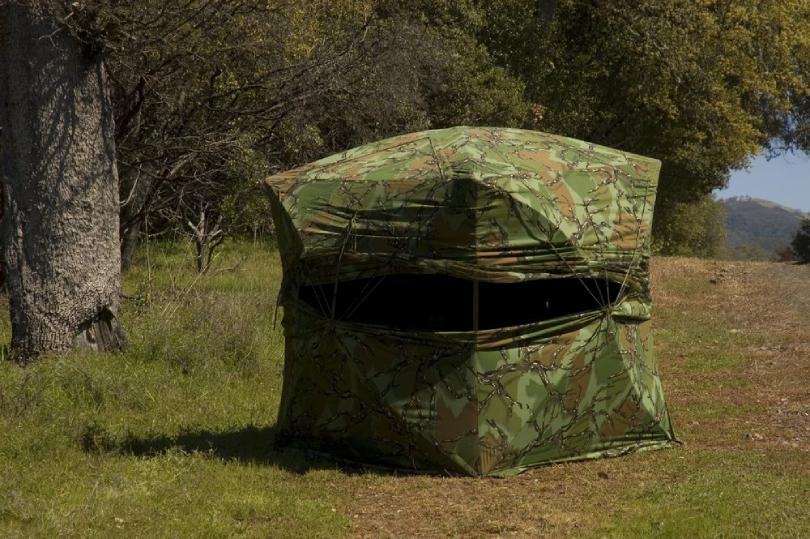Ground blinds are a comfortable and efficient way of hunting, but you need to know a thing or two to increase your odds of success. Our ground blind tips and tricks are here for you to employ and make your next hunting season a great success!
Let’s dive into our Pro ground blind hunting tips and explore how you can use them to the fullest.
Ground Blind Hunting Tips
1. Find the perfect location
On a deer hunting mission, you’ll have two places to check out: the deer’s resting area and the food spot. Look for dense covers to set up a ground blind with a more concealed look.
However, don’t compromise on the vision through the window. Use a hay-bale blind if you’re in the open field.
You must always stay cautious because deer possess a sharp sense of sight, smell, and hearing.
For turkey hunting, blind placement can be anywhere because they don’t have great senses.
2. Ground blind setup
Be vigilant about the blind’s setup. The door is the blind’s most noticeable part for a deer. It should be well-concealed so you become invisible after entering the blind. Keep in mind that even an approaching deer will run away if you’re seen or heard.
Moreover, pay attention to the ground and the window opening. Clean the ground well, even if yours is elevated.
That way, you can avoid stepping on any leaves or debris, alerting the prey. Clear your windows to get the best view.
3. Bowhunting through ground blind
Bowhunting from a ground blind is a bit more complicated than rifle hunting. Always be careful about your weapon (whether you prefer a crossbow or a compound bow) and the space it covers. This will help you not to spook away your prey.
Make sure you have plenty of space to draw the bow back comfortably. Hiding your body, especially your hands and face, can be tricky.
Using a dedicated ground blind for bowhunting can be a great option. Stand back from the window and try to stay completely silent.
The window size should be manageable: a small opening will offer a better disguise. Don’t tackle your bow somewhere.
4. Rifle hunting through ground blind

Deer hunting rifles give a longer shot and cover a lesser space when compared to the bow. So, a small blind can work as well. Don’t compromise on camouflaging; if you’re not concealed properly, then it’s just a camp.
Be cautious about:
- Optic’s reflection,
- Binoculars’ glares (if using) coming out from the lenses,
- Glowing gun barrel.
You can fix these problems by staying away from the window. Try to stand back in the dark and lower your rifle scope.
5. Water and snow resistant
Most importantly, plan a solution for waterproofing the blind. Although some waterproof flaps are available on the market, the best option is to use silicone spray.
Silicone spray is used on different materials, such as doors, to make them weather-resistant (rain and snow). It’s also used to make the blinds waterproof. This spray will provide a layer on the blind, so the water will slip off and not harm your blind sheet.
6. Scouting
Scouting works as a building block in any type of hunting. It’s not a random guess; you’ll need to find an area suitable to set up the blind. Without it, you’ll end up empty-handed.
When scouting deer, there are certain things to do: keeping an eye on the deer and locking all the feeding and bedding areas. This will help you find the best spot for hunting from a ground blind.
Avoid following your past experiences because animals keep changing their locations due to changes in the weather and food sources.
7. Brush-in a ground blind
Even though you can buy some camo tarp, you won’t be able to hide the blind’s shape entirely. So, you’ll need to brush in the blind for a more blended look with nature.
Pick up a pair of pliers or hand pruners to cut and trim the leafy branches, tree limbs, and anything to enhance the natural look.
Once that is complete, wrap the vegetation around the blind. Moreover, spread them around the blind to get a better landscape.
8. Camouflaging
Most blinds hold their manufacturing smell. Even though some blinds have an odor suppressor, the deer can still detect the smell.
Use branches and other vegetation to camouflage the blind with the landscape. To cover the smell, use fresh vegetation.
If you use dead vegetation, make sure they retain its natural scent. You can set up the blind some days before and leave it outside to absorb the natural scent. You can also use scent-elimination products.
9. Think like a prey
The next on today’s ground blind hunting tips is to imitate the thought process of the prey. Try to think and act like a deer.
When looking for the right destination, try to get into the prey’s head to see its available options. Find an area with isolated food and waterholes, as those are ideal places for deer to hang out.
The location of your blind will be where food and water are available to the prey, compelling it to approach you.
You also have the option to use deer baits like deer calls or deer attractants. While scouting, if you find a waterhole with some deer roaming around, then set up your blind there. You’ll most likely see every one of the animals there.
10. Wind and Sun’s roles
Sunlight and wind direction play considerable roles in concealing your movement, especially when hunting in a ground blind. A whitetail deer is incredible at smelling and hearing.
Remember, no scent-eliminating spray can obliterate your natural scent entirely. So, examine the wind direction, and pick the right place to avoid spooking the deer.
The whitetail can easily see the sunlight that hits your face. Therefore, pick the sides for morning and evening or build two blinds: one for the morning and one for the evening.
11. Restricted movement
Don’t set your angles or scope at a particular spot. That will restrict your horizon and make you lose your target in seconds with a single shooting lane.
As you know, it takes time to lock the target, judge the hunting area, and position the weapon.
Find a place where you can see the deer’s movements at different ranges and levels. This will give you a perfect shot with different shooting lanes and more time to lock the target.
12. Comfort zone
Slow and steady wins the race, remember? Deer hunting with ground blinds is time-consuming, so make yourself comfortable.
Don’t wait by the window all the time. Get a comfortable blind chair to sit in. Have a sleeping bag to rest in there too. If you rest and get fresh, you’ll have a better chance to fill the bag.
You might face harsh weather conditions. So, prepare yourself for that as well. You can take snacks and mobile phones with you, but be careful about the sound, light, and litter you produce.
13. Patterning the deer
You are supposed to pattern the whitetail deer before it predicts the human presence. Mature bucks could change their whole routine and pattern if they sense any threat.
Try installing the blind at least a week earlier to eliminate the materials’ smell and absorb the natural smell. As a result, your blind will become a familiar sight for the deer, so it won’t suspect any danger.
Use black clothes or camo clothes to conceal yourself properly in the blind.
14. Right wind direction
Finding the right wind direction is also extremely important.
One reason is that the wind can slightly change your bullet or arrow direction, and this minor change can make you miss the target.
For the rifle, use a modified scope to help you be more precise about the bullet travel.
Secondly, the wind can take your or the blind’s scent to the deer, causing it to flee. Hence, waiting for the right wind is vital instead of wasting time.
15. Installing a blind after proper scouting
Clearly, ground blinds are not a choice when you’re scouting. However, once you’re done scouting and knowing all the visiting spots of the prey, you’re ready to set up a ground blind.
At this moment, the blind will help you conceal yourself. A brushed-in ground blind will provide the best place to hide your movement and smell. With this blind, even big games like the ever-vigilant whitetail deer won’t have a clue about your presence.
16. Portability
This is the last on our ground blind hunting tips for today. Find out about the bedding and feeding spots of the deer and set up near those areas.
If the worst happens and you don’t find anything for days, you should move from the place and follow their route.

Most pop up ground blinds are portable and easy to move. You can detach your blind in no time, fill in your range bag, and easily install it somewhere else. Due to their portability, blinds are a great deer-hunting tool.
Conclusion
We believe our tips will greatly help increase your chances of success when out in the wild. Find a good spot, set up your blind, and wait patiently for that clean, humane shot. Happy Shooting!
FAQs
1. Can deer see you in a ground blind?
Ans. Yes and No! At a close distance, it can see you when you make small movements. And no, when you make a calculated movement. So, stand back in the blind to avoid giving any perceptive glimpse of yours, or your weapon.
2. Will a ground blind scare deer?
Ans. Unfortunately, yes. It can scare off the deer, but you can avoid this by wrapping the camo tarp with vegetation. To avoid its smell, use cedar woods or some smell-eliminator around the blind.
3. Do ground blinds control scent?
Ans. Normally, ground blinds don’t control scent. There are two ways to eliminate that smell:
- Wrap vegetation around the blind and keep it there for some weeks
- Use a odor-suppressor spray
4. Should you wear black in a ground blind?
Ans. Ground blinds need to be dark inside. So, it’s good that you put on dark clothing to mix with that habitat. What’s even better is to wear camo clothes and makeup though that’s not applicable to your base layer.
5. Do ground blinds spook deer?
Ans. Yes. If you don’t conceal yourself or your blind properly, you can easily spook the deer because they have a kin sense of smell and sight. Keep this in mind when making a ground blind yourself.








Leave a Comment